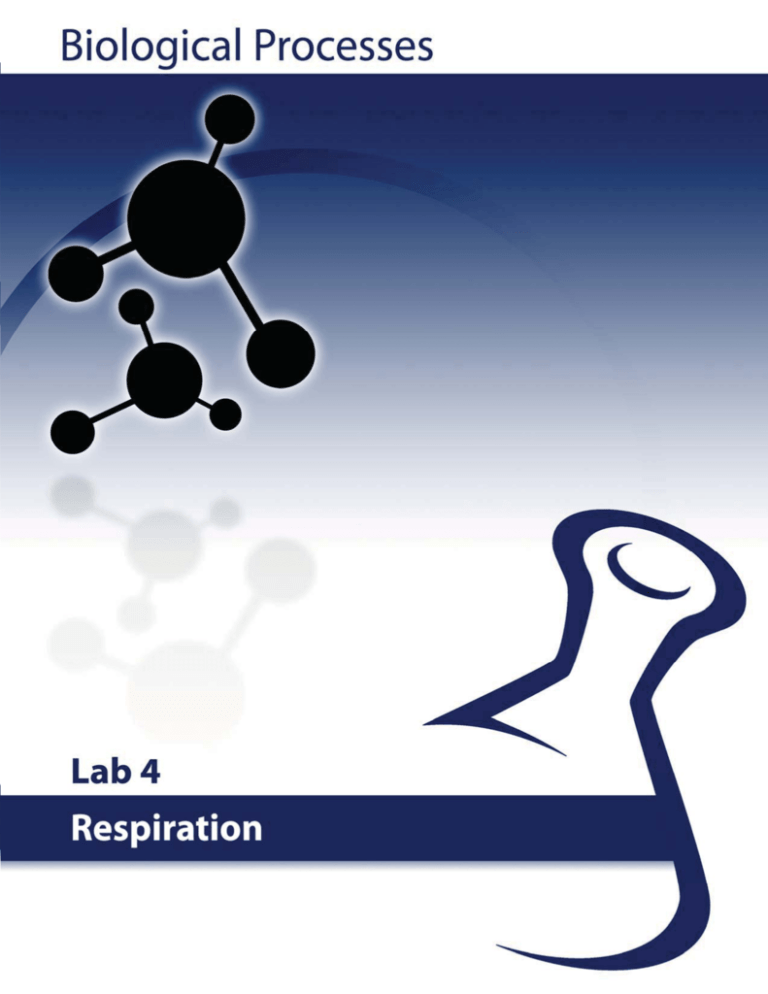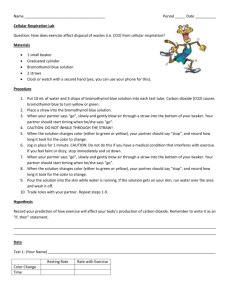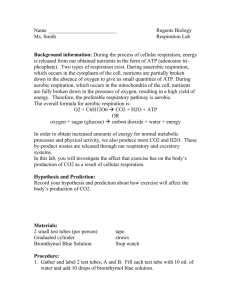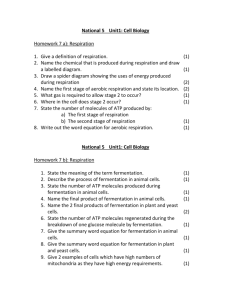College Biology for Science Majors WITHOUT
advertisement

Lab # 4: Respiration Lab4:Respiration Conceptscovered 9CellularEnergy 9Respiration 9AnaerobicRespiration(doesnotrequireoxygen) 9AerobicRespiration(requiresoxygen) ATPistheenergycurrencyofthecell.Itisproducedthroughaprocesscalledrespiration. Theenergymolecules(ATP)generatedthroughrespiration,areavailabletofueltheprocessesofthe cellasneeded.WhenATPlevelsbecometoolowaspecialproteinsignalsthecelltobeginrespiration. Aslongasallthecriticalcomponentsforthereactionareavailable,thiscycleprovidesaconstant sourceofenergyforthecell. Respirationharvestsbiologicalenergyfromfuelmolecules,suchascarbohydrates,andstoresitasATP. Togetherwithoxygen,thecellconvertscarbohydratestocarbondioxide,waterandenergy.Asshown intheequationbelow,respirationisacontrolled,multistepprocesswhichslowlyreleasestheenergy storedinglucoseandconvertsittoATP.Ifallofthisenergyfromglucosewerereleasedatonce,most wouldbelostasheatandlight. Carbohydratescontainhighenergybondsthat,whenbroken,releaseelectrons.Thefirststageofres piration,glycolysis,breakscarbohydrates(glucose)intopyruvatemolecules.Thoughthebondshold ingpyruvatetogethercontainagreatdealofpotentialenergy,thisstepyieldslittleenergy. Glycolysisoccurswithorwithoutoxygenandtakesplaceinthecytoplasmoutsidethemitochondria. Interestingly,itisapathwayfoundinalllivingthings. C6H12O6+6O26CO2+6H2O+energy glucoseoxygencarbondioxidewater Yeasthasbeenusedtomakeleavenedbread forcenturies.Whenyeastundergoesfermen tation,CO2istrappedandcausesthebreadto rise.Ethanol,anotherbyproductofyeast fermentation,generatesthealcoholcontent inbeer,andtheCO2provideseffervescence. Whatingredientsmustbepresentinorderfor thisprocesstooccur? Lab # 4: Respiration Thesecondstage,calledanoxidationreactionortheKrebsCycle,isalwayscoupledwithareduction reaction.Bothinvolvethemanipulationofelectrons.Theprocessusedatthispointinrespiration dependsonthepresenceofoxygen(aerobicrespiration)orwithoutoxygen(anaerobicrespiration). Membrane Anaerobic Aerobic 2 ATP in mitochondria 6 Carbon Compound Glucose 4 ADP Oxidation 4 ATP 3 Carbon Compound 2 ATP Alcohol + CO2 Cytosol +O2 Pyruvate Yeast fermentation CO2 + H2O Homolactic fermentation Lactic Acid Aerobicrespirationtakesplaceinthemitochondria(a specializedorganelle)ofthecellandusesoxygenas thefinalelectrontransporter.Inthisprocess,pyruvate isoxidizedtogenerateenergy.Thekeytoefficiencyin thisstepistheuseofoxygentoshuttleelectrons. 34 ADP 34 ATP Mitochondrion However,iftheelectronsreleasedweretransferred directlytooxygen,itwouldcombust.Toavoidthis, specialmoleculesshuttleelectronstotheATP productionsite.Sinceoxygenhasaveryhighaffinity forelectrons,aerobicrespirationisthemostefficient meansofproducingATP(36perreaction). Figure4.1:AerobicRespiration Anaerobicrespirationtakesplaceinthecytoplasmofthecellandusesother,lessefficient,molecules totransportelectrons.Ifthefinaltransfermoleculeisorganic(containsacarbonatom),theprocessis calledfermentation.Fermentationisananaerobicprocessthatusesenzymestoreducepyruvateinto energyrichmolecules.Becauseitcannotfullybreakdowntheglucosemolecule,fermentationisfar lessefficientthanaerobicrespiration,generatingonlytwoATPmolecules. Duringphysicalactivity,cellsrequiremore energy.Aslongasenoughoxygencanbe deliveredtocells,aerobicrespiration dominates. Whenenergyconsumptionexceedsthe oxygensupply,anaerobicrespirationstarts. Lacticacidisabyproduct,andiswhatcauses musclesorenessafterahardworkout! Lab # 4: Respiration Experiment4.1:FermentationinYeast YeastcellsproduceethanolandCO2duringfermentation.WewillmeasuretheproductionofCO2to determinetherateofanaerobicrespirationinthepresenceofdifferentcarbohydrates. Wewillbeusingtwodifferenttypesofsugarsinthislab: x Sucrose(adisaccharide)ismadeupofglucoseandfructose x Glucoseisamonosaccharide Defineforthisexperiment: Hypothesis: Control(s): IndependentVariable(s): DependentVariable(s): Materials 5Respirometers:(twotesttubesthatfitintoeachother)–smallplasticandlargeglass 1%solutionsofglucose,sucrose Equal,SplendaandSugarPackets Yeast (4)250mlbeaker *Warmwater Pipettes *Watchortimer Permanentmarker Ruler MeasuringSpoon *Youmustprovide Lab # 4: Respiration Procedure 1. Completelyfillthesmallesttubewithwaterandinvertthelargertubeoverit.Pushthesmall tubeup(intothelargertube)untilthetopconnectswiththebottomoftheinvertedtube (Figure4.2).Inverttherespirometersothatthelargertubeisupright(thereshouldbeasmall bubbleatthetopoftheinternaltube).Repeatthisseveraltimesaspractice–striveforthe smallestbubblepossible.Whenyoufeelcomfortablewiththistechnique,emptythetesttube andcontinuewiththisexperiment. Figure4.2:Respirometer 2. Mix1/4teaspoonofyeastinto175mLofwarm(4043°C)waterina250mLbeaker.Stiruntil dissolved. Note:Makesuretheyeastsolutionisstirredbeforeeachtesttubeisfilled. 3. Labelboththebigandsmalltesttubes15withamarker. 4. Ina250mlbeaker,mixthepacketofEqualwith100mlofwater.Inanother250mlbeaker,mix thepacketofSplendawith100mlofwater.Inanother250mlbeaker,mixthepacketofsugar with200mlofwater.Thesearenow1%solutions. 5. Fillthesmallertubeswith15mLsolutionasfollows: Tube1:1%glucosesolution Tube2:1%sucrosesolution Tube3:1%Equalsolution Tube4:1%Splendasolution Tube5:1%sugarsolution Note:Makesureyourinsethegraduatedcylinderbetweeneachuse. 6. Then,filleachtubetothetopwiththeyeastsolution. 7. Slidethecorrespondinglargertubeoverthesmalltubeandinvertitaspracticed.Thiswillmix theyeastandsugarsolutions. Lab # 4: Respiration 8. Placerespirometersinthetesttuberackandmeasuretheinitialairspaceintherounded bottomoftheinternaltube.RecordthesevaluesintheTable4.1. 9. Allowthetesttubestositinawarmplace(~37C)foronehour.Thismaybeasunny windowsill,atopawarmoven,underaverybright(warm)light,etc. 10. Attheendoftherespirationperiod,measuretheairspaceintheinternaltubes,andrecordit inTable4.1. Table4.1:RecordingRespirometerValues Tube Initialgasheight(mm) Finalgasheight(mm) NetChange 1 2 3 4 5 Questions 1. Didyounoticeadifferenceintherateofrespirationbetweenthevarioussugars?Didthe “fake”sugarprovideagoodstartingmaterialforfermentation? 2. Howdoyouknowthatanaerobicfermentationwasoccurring? Experiment4.2:AerobicRespirationinSoybeans Wewillevaluaterespirationinbeansbycomparingcarbondioxideproductionbetweengerminated andnongerminatedbeans.Asshowninthebalancedequationforcellularrespiration,oneoftheby productsofrespirationisCO2(carbondioxide): C6H12O6+6H2O+6O2energy+6CO2+12H2O Lab # 4: Respiration Wewilluseacarbondioxideindicator(bromothymolblue)toshowoxygenisbeingconsumedandcar bondioxideisbeingreleasedbythebeans. Bromothymolblueisanindicatorthatturnsyellowinacidicconditions,greenwhenitisneutraland bluewhenitisinbasicconditions. Defineforthisexperiment: Hypothesis: Control(s): IndependentVariable(s): DependentVariable(s): Materials 100beans (3)250mlbeakers *Papertowels 3measuringcups Pipette Bromothymolbluesolution Parafilm 3Rubberbands *Water *Youmustprovide Figure4.3:BeakerSetup Procedure 1. Soak50beansfor24hoursin200mlwater. 2. Labelthreebeakers:Beaker1,Beaker2,andBeaker3. 3. Placeseverallayersofmoistpapertowelsatthebottomofthe250mlbeakers. 4. Place50presoakedbeansintoBeaker1,50control(dry)beansinBeaker2,andzerobeansin Beaker3. 5. Dispense4mlofbromothymolbluesolutionintothebottomofeachmeasuringcup,andplace onemeasuringcupinsideeachbeakerontopofthebeans. 6. StretchtheParafilmacrossthetopofeachbeaker.Securewitharubberbandtocreateanair tightseal(Figure4.3). Lab # 4: Respiration 7. Placethebeakersonashelfortable,andletsitundisturbedatroomtemperature. 8. Observethejarsat10minuteintervalsforthreehours,andrecordanycolorchangeofthe bromothymolblueinTable4.2. Table4.2:Colorchangesofthebromothymolblueovertime Time Jarwithpresoakedbeans Jarwithunsoakedbeans Jarwithnobeans 0min 30min 60min 90min 120min 150min 180min Questions 1. Howdidthecolorofthebromothymolbluesolutionineachbeakerchangeovertime? 2. Whatcanbeinferredfromthecolorchangeofthebromothymolbluesolution? 3. Whatisthemechanismdrivingthebromothymolbluesolutioncolorchange? 4. Whatarethecontrolsinthisexperiment,andwhatvariablesdotheyeliminate?Whyisit importanttohaveacontrolforthisexperiment?








